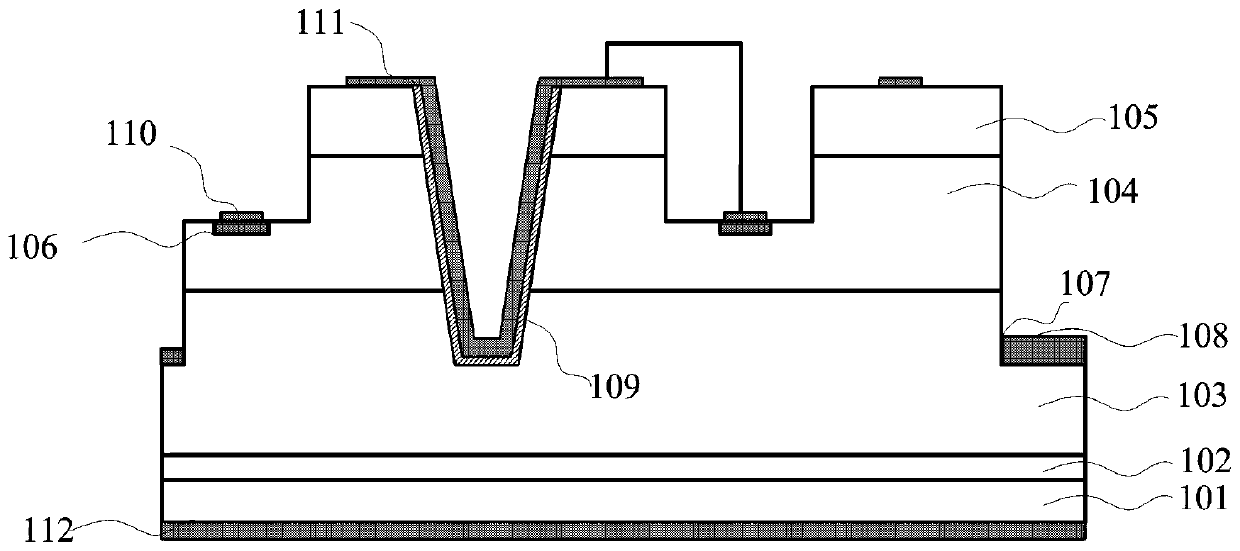An integral silicon carbide Darlington tube and its manufacturing method
A Darlington tube, integrated technology, applied in the field of microelectronics, can solve the problems of complex manufacturing process, small current handling capacity of the drive tube, and high cost
- Summary
- Abstract
- Description
- Claims
- Application Information
AI Technical Summary
Problems solved by technology
Method used
Image
Examples
Embodiment 1
[0050] In the first step, an N+ buffer layer 102 is epitaxially grown on the N+ substrate 101 . Specifically, as Figure 2A As shown in the figure, the N+ substrate 101 was first cleaned by RCA standard; then, the front surface of the N+ substrate 101 was epitaxially grown by a low-pressure hot-wall chemical vapor deposition method with a thickness of 3.5 μm and a nitrogen ion doping concentration of 8×10 17 cm -3 The N+ buffer layer 102.
[0051] It should be noted that the growth conditions of the N+ buffer layer 102 are as follows: the temperature is 1600° C., the pressure is 100 mbar, the reaction gas includes silane and propane, the carrier gas is pure hydrogen, and the impurity source is liquid nitrogen.
[0052] It should be noted that the RCA standard cleaning method was pioneered in 1965 by Kern and Puotinen et al. in the RCA laboratory in N.J.Princeton, from which it was named. RCA is a typical and still the most commonly used wet chemical cleaning method. The cle...
Embodiment 2
[0087] In step 1, an N+ buffer layer 102 is epitaxially grown on the N+ substrate 101 . Specifically, as Figure 2A As shown in the figure, the N+-type silicon carbide substrate 10 is firstly cleaned by RCA standard; 18 cm -3 the buffer layer 102 .
[0088] It should be noted that the growth conditions of the N+ buffer layer 102 are as follows: the temperature is 1600° C., the pressure is 100 mbar, the reaction gas includes silane and propane, the carrier gas is pure hydrogen, and the impurity source is liquid nitrogen.
[0089] Step 2, epitaxially growing the N- collector region 103 on the N+ buffer layer 102, specifically, as Figure 2B As shown, on the buffer layer 102, the epitaxial growth thickness is 100 μm by the low pressure hot-wall chemical vapor deposition method, and the nitrogen ion doping concentration is 2×10 14 cm -3 The N-collector region 103.
[0090] It should be noted that the growth process conditions of the N-collector region 103 are as follows: the...
Embodiment 3
[0116] In step A, the N+ buffer layer 102 is epitaxially grown on the N+ substrate 101 . Specifically, as Figure 2AAs shown in the figure, the N+-type silicon carbide substrate 10 is first cleaned by RCA standard; 18 cm -3 the buffer layer 102 .
[0117] It should be noted that the growth conditions of the N+ buffer layer 102 are as follows: the temperature is 1600° C., the pressure is 100 mbar, the reaction gas includes silane and propane, the carrier gas is pure hydrogen, and the impurity source is liquid nitrogen.
[0118] Step B, epitaxially growing the N- collector region 103 on the N+ buffer layer 102, specifically, as Figure 2B As shown, on the buffer layer 102, the epitaxial growth thickness is 105 μm by the low pressure hot-wall chemical vapor deposition method, and the nitrogen ion doping concentration is 6×10 14 cm -3 The N-collector region 103.
[0119] It should be noted that the growth process conditions of the N-collector region 103 are as follows: the t...
PUM
| Property | Measurement | Unit |
|---|---|---|
| width | aaaaa | aaaaa |
| thickness | aaaaa | aaaaa |
| thickness | aaaaa | aaaaa |
Abstract
Description
Claims
Application Information
 Login to View More
Login to View More - R&D
- Intellectual Property
- Life Sciences
- Materials
- Tech Scout
- Unparalleled Data Quality
- Higher Quality Content
- 60% Fewer Hallucinations
Browse by: Latest US Patents, China's latest patents, Technical Efficacy Thesaurus, Application Domain, Technology Topic, Popular Technical Reports.
© 2025 PatSnap. All rights reserved.Legal|Privacy policy|Modern Slavery Act Transparency Statement|Sitemap|About US| Contact US: help@patsnap.com



